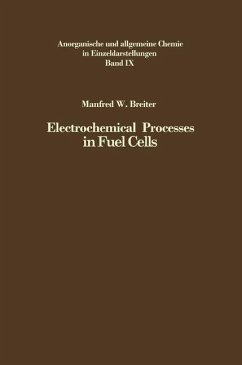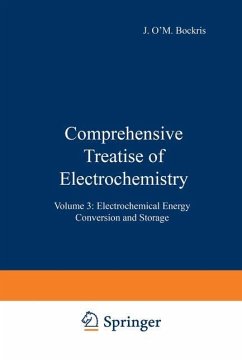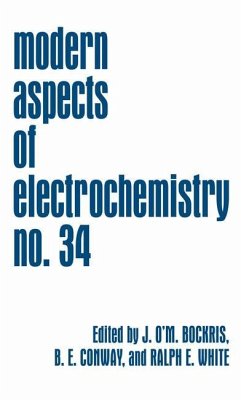Manfred W. Breiter
Electrochemical Processes in Fuel Cells
Manfred W. Breiter
Electrochemical Processes in Fuel Cells
- Broschiertes Buch
- Merkliste
- Auf die Merkliste
- Bewerten Bewerten
- Teilen
- Produkt teilen
- Produkterinnerung
- Produkterinnerung
The necessity for a better understanding of the basic processes that determine the operation of fuel cells became evident during the devel opment of practical units in the last three decades. The search for efficient electrocatalysts in low-temperature fuel cells intensified the general study of the nature and the role of the electrode material. Re search on the complex mechanisms of the anodic oxidation of different fuels and of the reduction of molecular oxygen on solid electrodes was stimulated, and the strong influence of adsorbed species on the electrode reaction in question was…mehr
Andere Kunden interessierten sich auch für
![Fuel Cell Systems Fuel Cell Systems]() Fuel Cell Systems154,99 €
Fuel Cell Systems154,99 €![Electrode Processes in Solid State Ionics Electrode Processes in Solid State Ionics]() M. Kleitz / J. Dupuy (Hgg.)Electrode Processes in Solid State Ionics153,99 €
M. Kleitz / J. Dupuy (Hgg.)Electrode Processes in Solid State Ionics153,99 €![Electrochemical Nanotechnologies Electrochemical Nanotechnologies]() Electrochemical Nanotechnologies112,99 €
Electrochemical Nanotechnologies112,99 €![Spectroelectrochemistry Spectroelectrochemistry]() Spectroelectrochemistry39,99 €
Spectroelectrochemistry39,99 €![Electrochemical Engineering and Energy Electrochemical Engineering and Energy]() Electrochemical Engineering and Energy38,99 €
Electrochemical Engineering and Energy38,99 €![Comprehensive Treatise of Electrochemistry Comprehensive Treatise of Electrochemistry]() Comprehensive Treatise of Electrochemistry78,99 €
Comprehensive Treatise of Electrochemistry78,99 €![Modern Aspects of Electrochemistry Modern Aspects of Electrochemistry]() Modern Aspects of Electrochemistry38,99 €
Modern Aspects of Electrochemistry38,99 €-
-
-
The necessity for a better understanding of the basic processes that determine the operation of fuel cells became evident during the devel opment of practical units in the last three decades. The search for efficient electrocatalysts in low-temperature fuel cells intensified the general study of the nature and the role of the electrode material. Re search on the complex mechanisms of the anodic oxidation of different fuels and of the reduction of molecular oxygen on solid electrodes was stimulated, and the strong influence of adsorbed species on the electrode reaction in question was investigated. Suitable electrolytes had to be found for the high-temperature fuel cells. The use of electrodes with large internal surface lead to the development of models of porous electrode. structures and to the mathematical analysis of the operation of these models under certain conditions. While the chapters I to III introduce the reader to the general field offuel cells, the progress made in the understanding of the basic problems in the electrochemistry of fuel cells since the end of the second world war is reviewed in chapters IV to XVI of this monograph. In contrast, the technological aspects necessary for the development of practical units are not covered here. The open literature published as books or as papers in scientific journals has been considered up to the time of the writing of the final draft of the specific chapter, at least till the end of 1967.
Produktdetails
- Produktdetails
- Anorganische und allgemeine Chemie in Einzeldarstellungen .9
- Verlag: Springer / Springer Berlin Heidelberg / Springer, Berlin
- Artikelnr. des Verlages: 978-3-642-46157-6
- Softcover reprint of the original 1st ed. 1969
- Seitenzahl: 292
- Erscheinungstermin: 8. März 2012
- Englisch
- Abmessung: 235mm x 155mm x 16mm
- Gewicht: 445g
- ISBN-13: 9783642461576
- ISBN-10: 3642461573
- Artikelnr.: 36116831
- Herstellerkennzeichnung
- Springer-Verlag GmbH
- Tiergartenstr. 17
- 69121 Heidelberg
- ProductSafety@springernature.com
- Anorganische und allgemeine Chemie in Einzeldarstellungen .9
- Verlag: Springer / Springer Berlin Heidelberg / Springer, Berlin
- Artikelnr. des Verlages: 978-3-642-46157-6
- Softcover reprint of the original 1st ed. 1969
- Seitenzahl: 292
- Erscheinungstermin: 8. März 2012
- Englisch
- Abmessung: 235mm x 155mm x 16mm
- Gewicht: 445g
- ISBN-13: 9783642461576
- ISBN-10: 3642461573
- Artikelnr.: 36116831
- Herstellerkennzeichnung
- Springer-Verlag GmbH
- Tiergartenstr. 17
- 69121 Heidelberg
- ProductSafety@springernature.com
I. Introduction.- 1. Definition and Description of a Fuel Cell.- 2. Classification of Fuel Cells.- 3. Historical Development.- References.- II. General Aspects.- 1. Thermodynamic Considerations and Definitions.- 2. Efficiency of Galvanic Cells.- 3. Basic Requirements for a Practical Fuel Cell.- 4. Electrolytes.- References.- III. Mass Transport Processes.- 1. Concept of the Nernst Diffusion Layer.- 2. Convective Diffusion.- 3. Migration and Convective Diffusion.- References.- IV. Kinetics of Electrode Reactions on Homogeneous Surfaces and Influence of Electrode Material.- 1. Single Step Reaction.- 2. Two Step Reaction with Adsorbed Intermediate.- 3. Successive Electrode Reactions with One Rate-Determining Step.- 4. Some Features of Mechanisms Involving the Simultaneous Formation of Different Products.- 5. Correlation between Hydrogen Overvoltage and Free Energy of Hydrogen Adsorption.- References.- V. Electrode Reactions on Heterogeneous Surfaces.- 1. Structure and Composition of Surfaces of Solids.- 2. Current Distribution on Heterogeneous Surfaces.- 3. Approximate Kinetic Expressions for Electrocatalytic Reactions on Heterogeneous Surfaces.- References.- VI. Characterization of the Surface of Platinium Metals and Platinum Metal Alloys by Hydrogen Adsorption and Comparison of the Results with Other Techniques.- 1. Electrochemical Determination of Isotherms of Hydrogen Adsorption.- 2. Heat of Hydrogen Adsorption as a Function of Coverage.- 3. Langmuir Approximation of the Isotherms of Hydrogen Adsorption.- 4. Influence of Surface Structure on Hydrogen Adsorption at Platinum.- 5. Determination of the Electrochemically Active Surface.- 6. Hydrogen Adsorption in the Presence of Chemisorbed Carbonaceous Species.- 7. Effect of Pretreatment on the Reactivity of Platinum MetalElectrodes.- 8. Hydrogen Adsorption on Binary Platinum Metal Alloys.- References.- VII. Anodic Oxidation of Molecular Hydrogen at Low Temperatures.- 1. Mechanism of the H2 Oxidation on Noble Metals and Noble Metal Alloys.- 2. Mechanism of the H2 Oxidation on Different Types of Nickel Electrodes in Alkaline Electrolytes.- 3. Mechanism of the H2 Oxidation on Platinum in Contact with an Ion-Exchange Membrane.- References.- VIII. Oxygen Layers on Different Materials and Inhibition of Fuel Oxidations.- 1. Formation and Reduction of Oxygen Layers on Platinum Metals and Some Alloys.- 2. Nature of the Oxygen Layers on Platinum Metals.- 3. Oxygen Layers on Nickel in Alkaline Electrolytes.- 4. Oxygen Layers on Silver in Alkaline Electrolytes.- 5. Oxygen Layers on Carbon.- 6. Inhibition of Fuel Oxidations by Oxygen Layers.- References.- IX. Adsorption of Carbonaceous Species on Platinum Metals.- 1. Non-Equilibrium Aspects of the Chemisorption of Strongly Bonded Carbonaceous Species.- 2. Adsorption of Weakly Bonded Carbonaceous Species.- 3. Rate of Formation of Strongly Bonded Species at Constant Potential.- 4. Coverage from Anodic Pulses.- 5. Coverage from Hydrogen Deposition.- 6. Radiometric Determination of the Coverage.- 7. Coverage and Capacitance of Electrode Impedance.- 8. Determination of the Number of Electrons in the Oxidation of Chemisorbed Species.- 9. Effect of pH and Anions on Coverage.- 10. Nature of Chemisorbed Species.- 11. Oxidation Mechanism of Chemisorbed Carbonaceous Species.- References.- X. Anodic Oxidation of Fuels at Low Temperatures.- 1. Classification of the Oxidation Mechanisms.- 2. Oxidation of Carbon Monoxide.- 3. Oxidation of Mixtures of Hydrogen and Carbon Monoxide.- 4. Oxidation of Formic Acid.- 5. Methanol Oxidation.- 6. Oxidation of Higher Alcohols and Aldehydes.- 7. Oxidation of Hydrocarbons.- 8. Oxidation of Hydrazine.- 9. Oscillatory Phenomena on Solid Electrodes.- References.- XI. The Oxygen Electrode at Low Temperatures.- 1. Distinction of Reduction Mechanisms.- 2. The Role of Hydrogen Peroxide in the Oxygen Reduction on Platinum Metals.- 3. Mechanism of the O2 Reduction on Active Platinum Metals in the Absence of the Oxygen Layer.- 4. The O2 Reduction on Platinum Metals in the Presence of Oxygen Layers.- 5. The O2 Reduction on Silver, Nickel, and Silver Alloys.- 6. The O2 Reduction on Carbon.- 7. The O2 Reduction on Intermetallic Compounds.- 8. The Reversible Oxygen Electrode.- References.- XII. Corrosion of Electrodes at Low Temperatures.- 1. Predictions from Potential-pH Diagrams.- 2. Dissolution of Platinum Metals.- 3. Dissolution of Nickel, Silver, and Carbon in Alkaline Electrolytes.- References.- XIII. Processes in Fuel Cells with Molten Carbonate Electrolytes.- 1. General Considerations.- 2. Properties of Molten Carbonate Electrolytes.- 3. Thermal Stability of Molten Carbonates and Corrosion of Metals.- 4. Formation of Carbon Deposits.- 5. Processes at the Anode.- 6. The Oxygen Electrode in Molten Carbonates.- References.- XIV. Processes in Fuel Cells with Solid Electrolytes.- 1. General Considerations.- 2. Properties of Solid Electrolytes.- 3. Current - Voltage Characteristics.- References.- XV. Properties of Porous Electrodes.- 1. Porosity.- 2. Determination of Different Surface Areas.- 3. Experimental Current-Potential Curves for Porous Electrodes.- 4. Structure and Performance.- References.- XVI. Models of Porous Electrodes.- 1. Potential Distribution in the Flooded Single Pore without Influence of Mass Transport Processes.- 2. Concentration Distribution in the Flooded Single Pore under theInfluence of Diffusion.- 3. Potential Distribution in the Flooded Single Pore in the Presence of Mass Transport Processes.- 4. Continuum Models of Flooded Porous Electrodes.- 5. The Thin Film Model of the Gas-Diffusion Electrode.- 6. The Meniscus Model of the Gas-Diffusion Electrode.- 7. Simultaneous Consideration of Thin Film and Meniscus.- 8. Model for the Two-Layer Electrode.- References.
I. Introduction.- 1. Definition and Description of a Fuel Cell.- 2. Classification of Fuel Cells.- 3. Historical Development.- References.- II. General Aspects.- 1. Thermodynamic Considerations and Definitions.- 2. Efficiency of Galvanic Cells.- 3. Basic Requirements for a Practical Fuel Cell.- 4. Electrolytes.- References.- III. Mass Transport Processes.- 1. Concept of the Nernst Diffusion Layer.- 2. Convective Diffusion.- 3. Migration and Convective Diffusion.- References.- IV. Kinetics of Electrode Reactions on Homogeneous Surfaces and Influence of Electrode Material.- 1. Single Step Reaction.- 2. Two Step Reaction with Adsorbed Intermediate.- 3. Successive Electrode Reactions with One Rate-Determining Step.- 4. Some Features of Mechanisms Involving the Simultaneous Formation of Different Products.- 5. Correlation between Hydrogen Overvoltage and Free Energy of Hydrogen Adsorption.- References.- V. Electrode Reactions on Heterogeneous Surfaces.- 1. Structure and Composition of Surfaces of Solids.- 2. Current Distribution on Heterogeneous Surfaces.- 3. Approximate Kinetic Expressions for Electrocatalytic Reactions on Heterogeneous Surfaces.- References.- VI. Characterization of the Surface of Platinium Metals and Platinum Metal Alloys by Hydrogen Adsorption and Comparison of the Results with Other Techniques.- 1. Electrochemical Determination of Isotherms of Hydrogen Adsorption.- 2. Heat of Hydrogen Adsorption as a Function of Coverage.- 3. Langmuir Approximation of the Isotherms of Hydrogen Adsorption.- 4. Influence of Surface Structure on Hydrogen Adsorption at Platinum.- 5. Determination of the Electrochemically Active Surface.- 6. Hydrogen Adsorption in the Presence of Chemisorbed Carbonaceous Species.- 7. Effect of Pretreatment on the Reactivity of Platinum MetalElectrodes.- 8. Hydrogen Adsorption on Binary Platinum Metal Alloys.- References.- VII. Anodic Oxidation of Molecular Hydrogen at Low Temperatures.- 1. Mechanism of the H2 Oxidation on Noble Metals and Noble Metal Alloys.- 2. Mechanism of the H2 Oxidation on Different Types of Nickel Electrodes in Alkaline Electrolytes.- 3. Mechanism of the H2 Oxidation on Platinum in Contact with an Ion-Exchange Membrane.- References.- VIII. Oxygen Layers on Different Materials and Inhibition of Fuel Oxidations.- 1. Formation and Reduction of Oxygen Layers on Platinum Metals and Some Alloys.- 2. Nature of the Oxygen Layers on Platinum Metals.- 3. Oxygen Layers on Nickel in Alkaline Electrolytes.- 4. Oxygen Layers on Silver in Alkaline Electrolytes.- 5. Oxygen Layers on Carbon.- 6. Inhibition of Fuel Oxidations by Oxygen Layers.- References.- IX. Adsorption of Carbonaceous Species on Platinum Metals.- 1. Non-Equilibrium Aspects of the Chemisorption of Strongly Bonded Carbonaceous Species.- 2. Adsorption of Weakly Bonded Carbonaceous Species.- 3. Rate of Formation of Strongly Bonded Species at Constant Potential.- 4. Coverage from Anodic Pulses.- 5. Coverage from Hydrogen Deposition.- 6. Radiometric Determination of the Coverage.- 7. Coverage and Capacitance of Electrode Impedance.- 8. Determination of the Number of Electrons in the Oxidation of Chemisorbed Species.- 9. Effect of pH and Anions on Coverage.- 10. Nature of Chemisorbed Species.- 11. Oxidation Mechanism of Chemisorbed Carbonaceous Species.- References.- X. Anodic Oxidation of Fuels at Low Temperatures.- 1. Classification of the Oxidation Mechanisms.- 2. Oxidation of Carbon Monoxide.- 3. Oxidation of Mixtures of Hydrogen and Carbon Monoxide.- 4. Oxidation of Formic Acid.- 5. Methanol Oxidation.- 6. Oxidation of Higher Alcohols and Aldehydes.- 7. Oxidation of Hydrocarbons.- 8. Oxidation of Hydrazine.- 9. Oscillatory Phenomena on Solid Electrodes.- References.- XI. The Oxygen Electrode at Low Temperatures.- 1. Distinction of Reduction Mechanisms.- 2. The Role of Hydrogen Peroxide in the Oxygen Reduction on Platinum Metals.- 3. Mechanism of the O2 Reduction on Active Platinum Metals in the Absence of the Oxygen Layer.- 4. The O2 Reduction on Platinum Metals in the Presence of Oxygen Layers.- 5. The O2 Reduction on Silver, Nickel, and Silver Alloys.- 6. The O2 Reduction on Carbon.- 7. The O2 Reduction on Intermetallic Compounds.- 8. The Reversible Oxygen Electrode.- References.- XII. Corrosion of Electrodes at Low Temperatures.- 1. Predictions from Potential-pH Diagrams.- 2. Dissolution of Platinum Metals.- 3. Dissolution of Nickel, Silver, and Carbon in Alkaline Electrolytes.- References.- XIII. Processes in Fuel Cells with Molten Carbonate Electrolytes.- 1. General Considerations.- 2. Properties of Molten Carbonate Electrolytes.- 3. Thermal Stability of Molten Carbonates and Corrosion of Metals.- 4. Formation of Carbon Deposits.- 5. Processes at the Anode.- 6. The Oxygen Electrode in Molten Carbonates.- References.- XIV. Processes in Fuel Cells with Solid Electrolytes.- 1. General Considerations.- 2. Properties of Solid Electrolytes.- 3. Current - Voltage Characteristics.- References.- XV. Properties of Porous Electrodes.- 1. Porosity.- 2. Determination of Different Surface Areas.- 3. Experimental Current-Potential Curves for Porous Electrodes.- 4. Structure and Performance.- References.- XVI. Models of Porous Electrodes.- 1. Potential Distribution in the Flooded Single Pore without Influence of Mass Transport Processes.- 2. Concentration Distribution in the Flooded Single Pore under theInfluence of Diffusion.- 3. Potential Distribution in the Flooded Single Pore in the Presence of Mass Transport Processes.- 4. Continuum Models of Flooded Porous Electrodes.- 5. The Thin Film Model of the Gas-Diffusion Electrode.- 6. The Meniscus Model of the Gas-Diffusion Electrode.- 7. Simultaneous Consideration of Thin Film and Meniscus.- 8. Model for the Two-Layer Electrode.- References.








